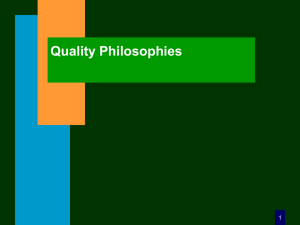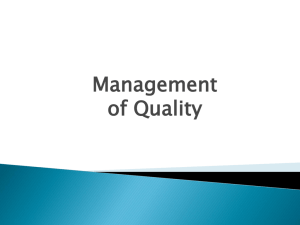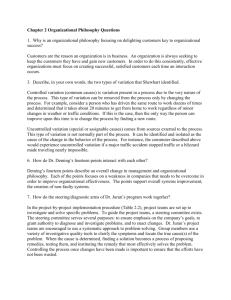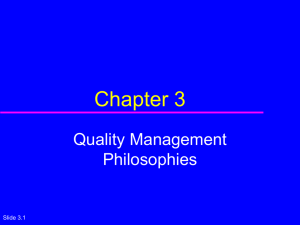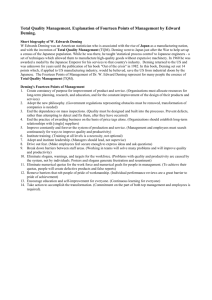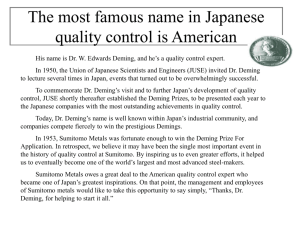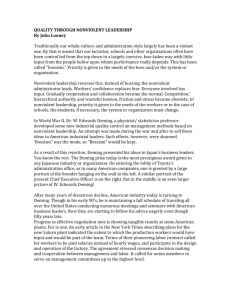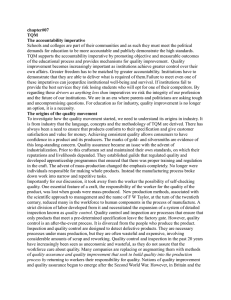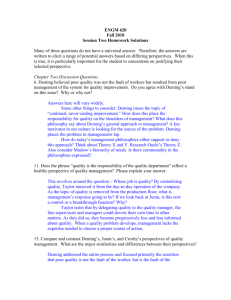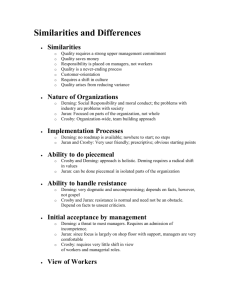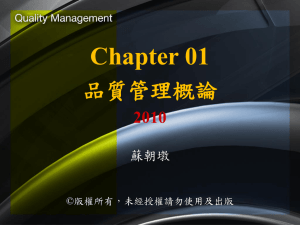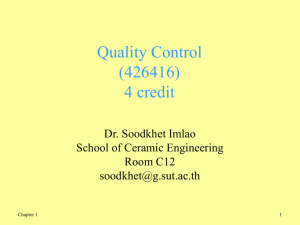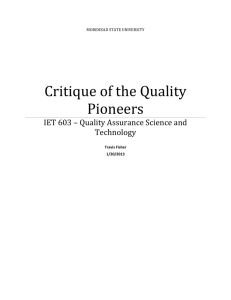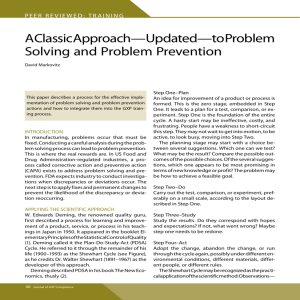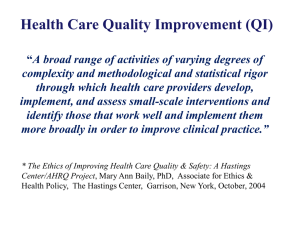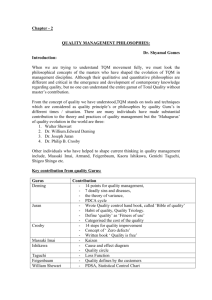A History of Quality Management Part 1 1
advertisement
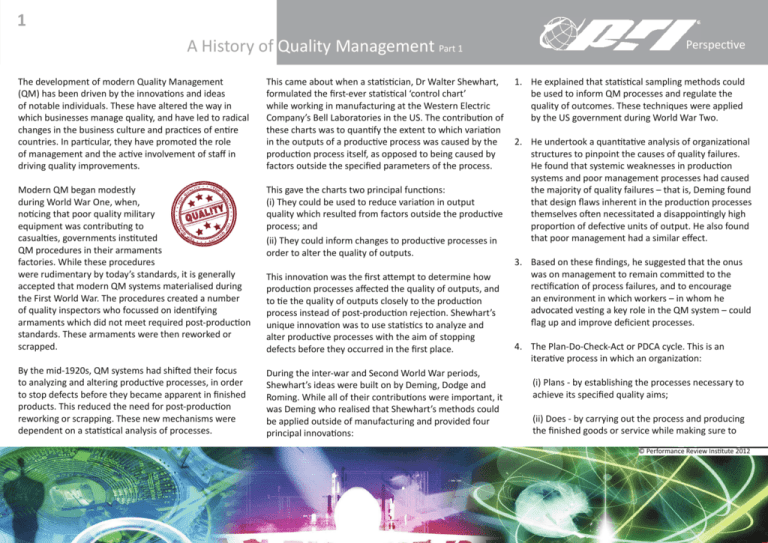
1 A History of Quality Management Part 1 The development of modern Quality Management (QM) has been driven by the innovations and ideas of notable individuals. These have altered the way in which businesses manage quality, and have led to radical changes in the business culture and practices of entire countries. In particular, they have promoted the role of management and the active involvement of staff in driving quality improvements. This came about when a statistician, Dr Walter Shewhart, formulated the first-ever statistical ‘control chart’ while working in manufacturing at the Western Electric Company’s Bell Laboratories in the US. The contribution of these charts was to quantify the extent to which variation in the outputs of a productive process was caused by the production process itself, as opposed to being caused by factors outside the specified parameters of the process. Modern QM began modestly during World War One, when, noticing that poor quality military equipment was contributing to casualties, governments instituted QM procedures in their armaments factories. While these procedures were rudimentary by today’s standards, it is generally accepted that modern QM systems materialised during the First World War. The procedures created a number of quality inspectors who focussed on identifying armaments which did not meet required post-production standards. These armaments were then reworked or scrapped. This gave the charts two principal functions: (i) They could be used to reduce variation in output quality which resulted from factors outside the productive process; and (ii) They could inform changes to productive processes in order to alter the quality of outputs. By the mid-1920s, QM systems had shifted their focus to analyzing and altering productive processes, in order to stop defects before they became apparent in finished products. This reduced the need for post-production reworking or scrapping. These new mechanisms were dependent on a statistical analysis of processes. During the inter-war and Second World War periods, Shewhart’s ideas were built on by Deming, Dodge and Roming. While all of their contributions were important, it was Deming who realised that Shewhart’s methods could be applied outside of manufacturing and provided four principal innovations: This innovation was the first attempt to determine how production processes affected the quality of outputs, and to tie the quality of outputs closely to the production process instead of post-production rejection. Shewhart’s unique innovation was to use statistics to analyze and alter productive processes with the aim of stopping defects before they occurred in the first place. Perspective 1. He explained that statistical sampling methods could be used to inform QM processes and regulate the quality of outcomes. These techniques were applied by the US government during World War Two. 2. He undertook a quantitative analysis of organizational structures to pinpoint the causes of quality failures. He found that systemic weaknesses in production systems and poor management processes had caused the majority of quality failures – that is, Deming found that design flaws inherent in the production processes themselves often necessitated a disappointingly high proportion of defective units of output. He also found that poor management had a similar effect. 3. Based on these findings, he suggested that the onus was on management to remain committed to the rectification of process failures, and to encourage an environment in which workers – in whom he advocated vesting a key role in the QM system – could flag up and improve deficient processes. 4. The Plan-Do-Check-Act or PDCA cycle. This is an iterative process in which an organization: (i) Plans - by establishing the processes necessary to achieve its specified quality aims; (ii) Does - by carrying out the process and producing the finished goods or service while making sure to © Performance Review Institute 2012 A History of Quality Management Part 1 collect quantitative data on the process and the quality of its outputs; (iii) Checks - through analysis of the data collected, identifying disjoints between the output quality desired in the planning phase and that which was achieved in the doing phase; and failures, making QM achievements directly comparable across organizations. Like Deming, Juran believed that workers had a key role to play in continuously driving quality improvements. Juran also exerted significant influence on Japanese QM culture. (iv) Acts - by improving the processes in line with the data analysis to move the quality of outputs closer to their desired level. During the post-WWII period, Deming exerted a significant influence on Japanese QM culture. Japanese industrialists were keen to use his ideas to re-grow their economy following defeat by the Allies. The application of Deming’s ideas contributed to improvements in the quality of Japanese goods. Deming’s ideas were encapsulated in his seminal work, Out of the Crisis and the Deming Prize was established in Japan in recognition of his unique contribution to QM. Following Deming, Juran made significant contributions to the theory and practice of QM. He highlighted that the quality of a product or service should take account of the degree to which it satisfies customer expectations, as opposed to purely capturing the degree to which it satisfied technical specifications. He pioneered the ‘Costs of Poor Quality’ approach which allowed organizations to quantify the cost of quality Perspective goods or services produced to be defective actually encourages defects. He also argued that the benefits of a robust QM program almost always outweigh the costs of its implementation, hence the title of his book. Crosby suggested that producing defective units did not need to be an accepted part of the process, stating that it was possible to eliminate defective units, while still meeting product specification and customer requirements. Crosby’s ideas contributed to attempts by businesses in the USA to address the issue of strong quality competition from Japanese businesses. Present day QM mechanisms typically employ statistical process control mechanisms, and emphasise management leadership and employee commitment to quality improvements. By the 1970s, the high quality of Japanese goods was beginning to weigh down on markets in the USA, which were producing comparatively low quality products. It was in this context that Crosby wrote Quality is Free in 1979, emphasising the notion of zero defects. Crosby asserted that it was possible to design and implement processes with no defective outputs. He argued that this should be the aim of QM processes, maintaining that allowing some positive proportion of This PRI Perspective has been created using information provided by the Chartered Quality Institute. For more information, visit their website at www.thecqi.org © Performance Review Institute 2012

